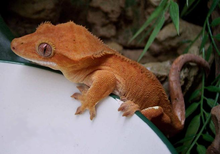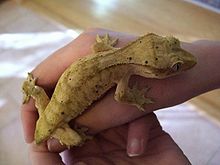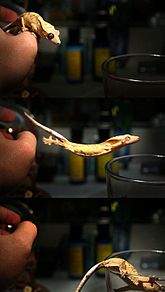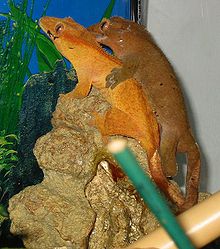- Crested Gecko
-
Crested Gecko 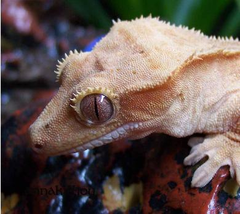
Conservation status Scientific classification Kingdom: Animalia Phylum: Chordata Class: Reptilia Order: Squamata Family: Gekkonidae Genus: Rhacodactylus Species: R. ciliatus Binomial name Rhacodactylus ciliatus
(Guichenot, 1866)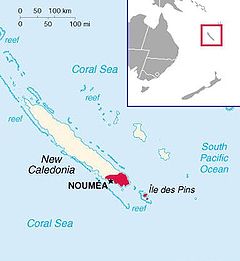
Approximate distribution of the Crested Gecko. Synonyms Correlophus ciliatus
The Crested Gecko, New Caledonian Crested Gecko, Guichenot's Giant Gecko or Eyelash Gecko, Rhacodactylus ciliatus, is a species of gecko native to southern New Caledonia. This species was thought extinct until it was rediscovered in 1994.[1] Along with several other Rhacodactylus species, it is being considered for protected status by the Convention on the International Trade in Endangered Species of Wild Flora and Fauna. It is popular in the pet trade.
Contents
Taxonomy
The generic name Rhacodactylus is Greek in origin: Rhakos, meaning "spine" and Dactylus meaning "finger". The specific name, ciliatus, is Latin: Cilia means "fringe" or "eyelash" and refers to the crest of skin over the animal's eyes that resembles an eyelash.
Physical description
The Crested Gecko has hair-like projections found above the eyes, resembling eyelashes. It has a wedge shaped head and a crest that runs from each eye to the tail. The toes and the tip of the semi-prehensile tail are covered in small hairs called setae. Each seta is divided into hundreds of smaller (approximately 200 nanometres in diameter) hairs called spatulae. It is believed these structures exploit the weak van der Waals force to help the gecko climb on most solid surfaces. The toes have small claws which aid in climbing surfaces to which their toes cannot cling.
The Crested Gecko has many naturally occurring color groups, some of which include: grey, brown, red, orange, and yellow of various shades. They have variable markings, which include spots, straight stripes, and tiger-like stripes. The markings and coloration are not geographic indicators; offspring of the same clutch may display differing coloration and markings. The colors are brighter and more prominent at night.
The Crested Gecko has distinct structural morphs in head size and crest abundancy. Geckos with a head length less than 1.3 times its width are considered "crowned" Crested Geckos. They can vary in the amount and size of the crests; some have crests that extend to the base of the tail and some lack crests on one side of their body.
Geographic distribution
The Crested Gecko is endemic to South Province, New Caledonia. There are three disjunct populations, one found on the Isle of Pines and surrounding islets, and there are two populations found on the main island of Grande Terre. One population is around the Blue River, which is a protected provincial park, and the other is further north, just south of Mount Dzumac.
Ecology and behavior
The Crested Gecko has no eyelids; a transparent scale, or spectacle, keeps its eyes moist and it uses its tongue to clear away debris. Like all Rhacodactylus geckos, it has webbing on its legs and digits. They are a mostly arboreal species, preferring to inhabit the canopy of the New Caledonian rainforests, and because of this they can jump considerably well. They are primarily nocturnal, and will generally spend the daylight hours sleeping in a secure spot in a tree. The Crested Gecko, unlike the closely related Gargoyle Gecko (Rhacodactylus auriculatus), will not regrow its tail once lost.[1] The cells around the base of the tail are brittle, allowing the tail to break away when threatened or caught by a predator. The capillaries to the tail will close almost instantly so there is little to no blood loss. The tails will move independently of the body for 2–5 minutes. The loss of their tail is not problematic, and most adults in the wild do not have their tails.
Unlike most species of gecko, this species is an omnivore, also considered frugiverous, feeding a variety of insects and fruit.[1]
Captivity
Though the export of wild Crested Geckos is now prohibited, biologists exported several specimens for breeding and study before the practice was outlawed.[1] From these specimens, different breeding lines were established both in Europe and the United States.[1] The Crested Gecko is now one of the most widely kept and bred species of gecko in the world.[1]
These geckos can be very long lived. While they have not been kept in captivity long enough for a definitive life span determination, they are thought to live for 15–25 years or more. They are usually fed crickets and a crested gecko supplement such as Repashy or fruit flavored baby food.
Reproduction
Little is known about the wild reproductive behavior of Crested Geckos, but in captivity they breed readily, with the female laying two eggs which hatch 60–90 days after they are laid. Eggs are generally laid at four week intervals as long as the fat and calcium reserves of the female are still at healthy levels. Crested Geckos have a small sac for calcium in their mouth. If an egg laying female does not have enough calcium her sac will be depleted, and she can suffer from calcium deficiency. This can lead to lethargy, lack of appetite, and even death.[1] Eggs laid by a female whose calcium reserves are low occasionally exhibit signs of metabolic bone disease, such as an under bite, or a sharp dip at the base of the tail.
It is undetermined whether heat plays a role in determining the sex of the embryo, as it can with other gecko species. Newly hatched Crested Geckos will generally not eat until after they shed their skin for the first time, relying on the remains of their yolk sack for nutrition.[1]
A female crested only has to mate with a male once in order to lay 2 eggs per month for upwards of 8-10 months. Retaining of sperm ensures the eggs the female lays remain fertile throughout her breeding cycle. After those 8-10 months, females in the wild go through a "cooling" cycle, usually prompted by slight temperature changes in winter, which help her regain lost nutrients from egg-laying. In captivity this cooling cycle must be controlled or the female will lay eggs continuously, even to death.
Status in the wild
Long believed extinct, the species was rediscovered in 1994 after a tropical storm.[1] It is currently being assessed for CITES protection and endangered status. The biggest single threat to the wild population appears to be the introduction of the little fire ant (Wassmania auropunctata) to New Caledonia.[1] The ants prey on the geckos, stinging and attacking in great numbers and also compete with the geckos for food by preying on arthropods.
See also
References
External links
- Bauer, Aaron M. & Sadlier, Ross A. 2000 The Herpetofauna of New Caledonia. Society for the Study of Amphibians and Reptiles. ISBN 0-916984-55-9
- Species Rhacodactylus ciliatus at The Reptile Database
- Biotropics Additional information, especially on husbandry in captivity
- Comprehensive Crested Gecko Care sheet
Categories:- IUCN Red List endangered species
- Reptiles of New Caledonia
- Gekkonidae
Wikimedia Foundation. 2010.


